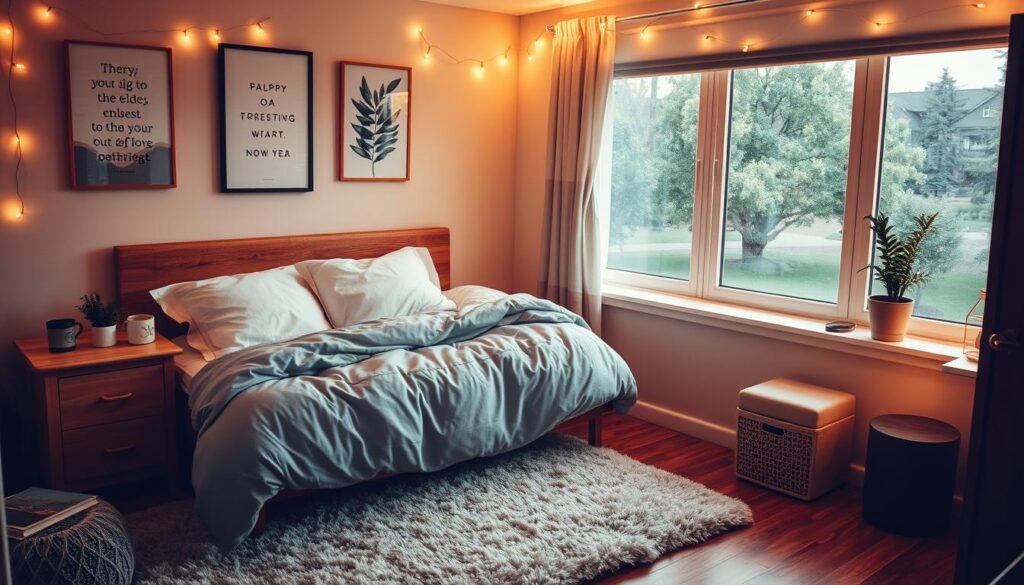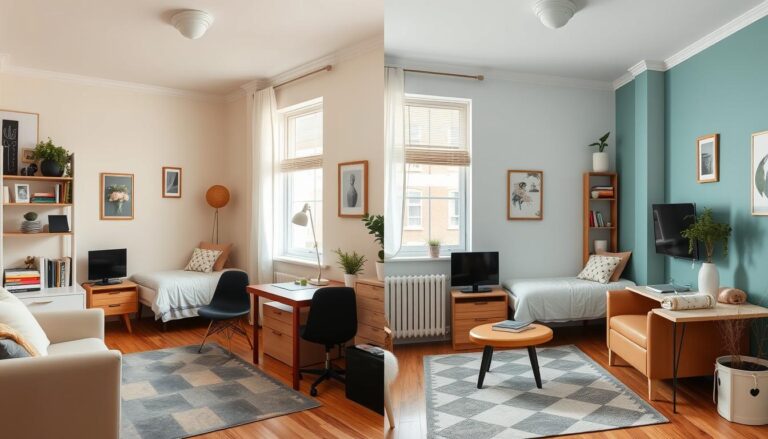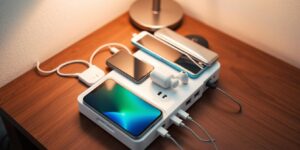Student sleep hacks: How to make your dorm bed actually comfortable
Get better sleep with these student sleep hacks. Find out how to make your dorm bed comfortable and improve your overall sleep experience.
College life often feels like a nonstop marathon. Between classes, clubs, and part-time jobs, restorative rest frequently gets pushed aside. Yet studies show 68% of Americans struggle to sleep weekly, with young adults particularly vulnerable to irregular schedules and environmental disruptions.

Dorm rooms present unique obstacles. Standard-issue mattresses rarely support proper spinal alignment, while shared spaces amplify noise and light pollution. These factors create a perfect storm for chronic fatigue – a condition linked to reduced focus and weaker immune systems.
This guide offers practical strategies to transform your sleeping area into a sanctuary. You’ll discover how simple adjustments to bedding choices and nighttime routines can significantly improve sleep quality. Better rest isn’t just about feeling refreshed – it directly impacts memory retention and problem-solving abilities crucial for academic success.
Key Takeaways
- Over two-thirds of Americans experience weekly sleep difficulties
- Sleep quality affects cognitive performance and physical health
- Dorm environments often lack proper sleep-supportive features
- Affordable solutions exist for common bedroom challenges
- Consistent routines enhance sleep patterns despite busy schedules
Understanding the Sleep Challenges Students Face
Balancing academic responsibilities with personal life often pushes nighttime recovery to the bottom of priority lists. Biological changes and social pressures collide, creating barriers to consistent rest. Let’s break down why this happens.
Biological Changes and Circadian Rhythms
Teenagers and young adults experience a natural shift in their internal clocks. Sleep expert Li Åslund notes: “The body’s preferred sleep window delays by 2-3 hours during adolescence, making early mornings biologically challenging.” This mismatch between natural rhythms and 8 AM classes results in chronic fatigue.
| Factor | Impact | Solution |
|---|---|---|
| Delayed melatonin release | Difficulty falling asleep before midnight | Evening light reduction |
| Early academic schedules | Accumulated rest deficit | Strategic nap planning |
| Hormonal fluctuations | Irregular sleep patterns | Consistent wake-up times |
Social Demands and Late-Night Distractions
Group chats and streaming services keep minds active when they should wind down. Studies show 73% of individuals use smartphones within an hour of bedtime, suppressing melatonin by 23%. Academic stress compounds this issue – elevated cortisol levels make deep rest phases elusive.
What Else Would You Like to Know?
Choose below:
Three key disruptors stand out:
- Blue light from devices resets internal clocks
- Social obligations extend waking hours
- Last-minute studying activates stress responses
These intertwined factors create cycles where sacrificing rest seems necessary, yet ultimately reduces cognitive sharpness. The next section explores practical fixes for dorm-specific obstacles.
Creating a Dorm Room Environment for Better Sleep
Your surroundings play a crucial role in achieving deep, uninterrupted rest. Strategic adjustments to bedding and room organization can transform cramped quarters into a sanctuary that supports recovery. Focus on these two areas to maximize comfort:
Optimizing Your Bed Setup and Room Layout
Start with the foundation – standard dorm mattresses often benefit from 3-inch memory foam toppers. Pair these with medium-firm pillows that keep your neck aligned. Breathable cotton sheets work best for temperature regulation, while weighted blankets (under 15 lbs) may ease restlessness.

Define clear zones in your space. Keep textbooks and laptops off the sleeping area to strengthen mental associations between your bed and relaxation. If possible, position furniture so your head faces away from doorways or windows to minimize disturbances.
Managing Light, Noise, and Temperature
Three environmental factors require attention for quality rest. Install blackout curtains or use a contoured sleep mask to block 98% of artificial light. For persistent hallway sounds, try brown noise machines – their low frequencies mask sharp noises better than white noise.
| Factor | Impact | Solution |
|---|---|---|
| Light Exposure | Disrupts melatonin production | LED dimmer switches |
| Noise Disturbances | Interrupts deep sleep phases | Foam earplugs + fan |
| Temperature Shifts | Causes wakefulness | Layered bedding system |
Maintain 65°F using programmable fans and moisture-wicking pajamas. Finally, declutter nightly – studies show tidy spaces reduce pre-rest anxiety by 19%.
Simple Strategies to Fall Asleep Faster
Transitioning from daytime hustle to nighttime calm requires intentional habits. Your body thrives on consistency – structured evening activities signal it’s time to power down. Start winding down 90 minutes before lights-out for optimal results.
Establishing a Relaxing Pre-Bedtime Routine
Dim overhead lights 60 minutes prior to bedtime. Swap screens for paperback books or instrumental playlists – research shows this reduces mental stimulation by 34%. Set phone reminders labeled “Wind Down” to avoid losing track of time during late-night tasks.
Try these science-backed methods to fall asleep faster:
- Practice 4-7-8 breathing: Inhale 4 seconds, hold 7, exhale 8
- Do gentle neck rolls and shoulder stretches
- Write tomorrow’s priorities in a notebook
Avoid thriller shows or heated debates before bed. These spike cortisol levels, making easier fall into rest nearly impossible. Instead, try progressive muscle relaxation:
- Lie flat and tense forehead muscles for 10 seconds
- Release tension while exhaling slowly
- Move downward through jaw, shoulders, and legs
Consistency matters most. Repeating the same routine nightly trains your brain to recognize sleep signals. Within three weeks, 82% of people report improved sleep onset times.
Managing Stress and Academic Pressure
High-pressure academic environments often trigger a cascade of physiological responses that sabotage recovery. Cortisol levels spike during intense study sessions, creating a 42% increase in nighttime wakefulness according to UCLA research. This biological chain reaction makes quality rest elusive when it’s needed most.
Practicing Mindfulness and Relaxation Techniques
Five-minute mindfulness exercises can reset your nervous system. Try the 5-4-3-2-1 grounding method before bed:
- Name five things you see
- Identify four physical sensations
- Listen for three distinct sounds
- Notice two smells
- Acknowledge one emotion
| Technique | Benefit | Time Required |
|---|---|---|
| Box Breathing | Reduces heart rate | 4 minutes |
| Body Scan | Releases muscle tension | 10 minutes |
| Guided Imagery | Lowers anxiety markers | 7 minutes |
Balancing Study and Rest
Create clear boundaries using the 50/10 rule: Study for 50 minutes, then step away for 10. During breaks:
- Stretch or walk outside
- Hydrate with non-caffeinated drinks
- Listen to nature sounds
Nightly journaling helps compartmentalize worries. List tomorrow’s top three priorities instead of seven – this narrow focus decreases stress by 28% while maintaining productivity. Apps like Sleep Cycle offer science-backed soundscapes that mask disruptive dorm noises.
Building a Consistent Sleep Schedule
Daily rhythms act as invisible conductors for your biological processes. When aligned properly, they orchestrate energy levels and mental clarity throughout waking hours. This synchronization becomes particularly vital during periods of demanding schedules.
Mastering Daily Time Anchors
Your body clock thrives on predictability. Research shows maintaining fixed bedtimes and wake-up times – even on weekends – improves alertness by 38%. Start by choosing a realistic window that allows 7-9 hours of rest, then stick to it within 30 minutes daily.
Three strategies help maintain rhythm during chaotic weeks:
- Use dawn simulator alarms instead of jarring sounds
- Charge devices outside arm’s reach overnight
- Plan wind-down activities 90 minutes before target bedtime
When adjusting schedules, make gradual 15-minute shifts every three days. This approach causes 53% less grogginess than abrupt changes according to chronobiology studies. For exam weeks or social events, limit variations to two hours from your standard routine.
| Challenge | Solution | Effectiveness |
|---|---|---|
| Weekend oversleeping | Morning light exposure | 82% improvement |
| Late-night studying | Power naps before 3 PM | 67% energy boost |
| Time zone changes | Melatonin supplementation | 74% faster adaptation |
Consistency creates self-reinforcing patterns. Within 21 days, most people report easier mornings and sustained afternoon focus. Remember – regularity trumps perfection when establishing lasting habits.
Controlling Caffeine, Blue Light, and Evening Activities
Modern lifestyles create invisible barriers to winding down effectively. Two major culprits – stimulants and screens – disrupt natural rhythms when managed poorly. Understanding their biological impacts helps create healthier evening patterns.
Smart Stimulant Management
Caffeine lingers in your system longer than most realize. A 3 PM latte can still affect alertness at 11 PM. Energy drinks pose greater risks – their higher concentrations amplify this delayed effect. Try these alternatives for afternoon slumps:
- 10-minute brisk walks boost circulation
- Almonds or apple slices provide slow-release energy
- 5-minute meditation sessions refresh focus
Blue light presents another challenge after sunset. Device screens emit wavelengths that trick brains into daytime mode. Research shows 90 minutes of pre-bed screen use delays melatonin release by 40 minutes. Combat this with:
- Automatic night mode settings after 8 PM
- Amber-tinted glasses for late-night work
- Physical books instead of e-readers
| Activity | Cutoff Time | Replacement |
|---|---|---|
| Coffee | 2 PM | Decaf herbal tea |
| Social media | 9 PM | Gratitude journaling |
| Intense workouts | 7 PM | Gentle yoga flows |
Establish device-free zones 60 minutes before bed. Charge phones across the room and enable “do not disturb” modes. These adjustments help separate wakeful activities from wind-down periods, making rest more accessible.
Incorporating Power Naps and Physical Activity
Midday energy crashes don’t have to derail productivity. Strategic recovery methods can boost alertness without compromising nighttime rest. The key lies in timing and moderation.
Mastering the Energy Reboot
Short power naps between 1-3 PM align with natural circadian dips. Limit sessions to 20 minutes – this prevents entering deep sleep stages that cause grogginess. Set phone alarms to avoid oversleeping.
Those struggling to fall asleep at night should skip daytime naps. Instead, try brisk walks or cold water splashes. These provide quick energy boosts without affecting evening routines.
Movement as Rhythm Regulator
Daily physical activity strengthens circadian rhythms. Aim for 30-minute sessions before dinner – morning workouts enhance focus, while afternoon movement reduces stress hormones. Campus stairs make ideal impromptu gyms.
Avoid intense workouts within 3 hours of bedtime. Gentle yoga or stretching works better for winding down. Pair movement with natural light exposure to reinforce your body’s internal clock.
Balancing rest and motion creates sustainable energy patterns. When timed correctly, these strategies help maintain sharpness throughout packed schedules while supporting nighttime recovery.
FAQ
How can I improve comfort in a dorm bed?
What’s the best way to block out light in shared spaces?
Can caffeine after noon really affect rest?
How long should a power nap be?
Does exercise timing matter for rest quality?
How do I manage stress from deadlines?
Can room temperature impact how fast I fall asleep?
The Best Colors to Make Your Student Apartment Feel Bigger
» See exclusive tips for your home








